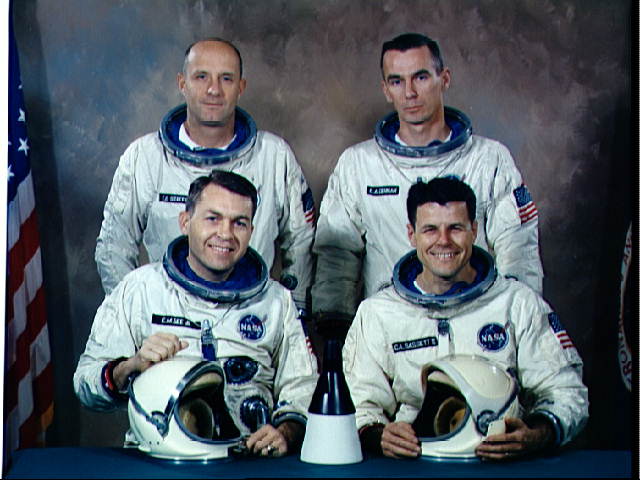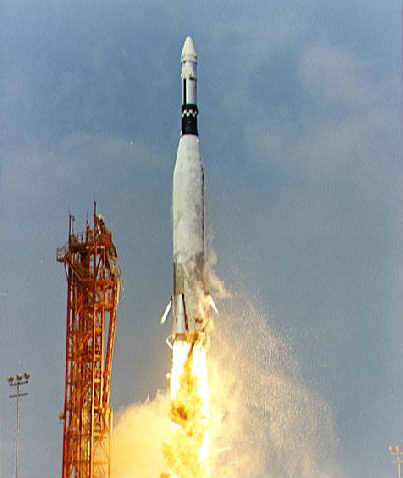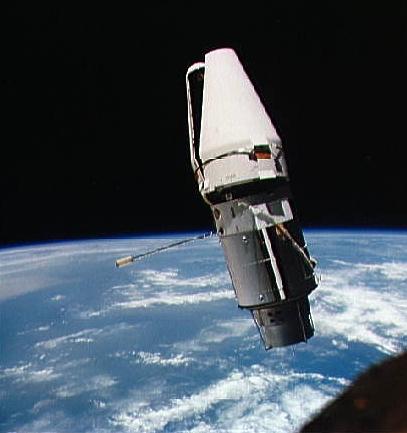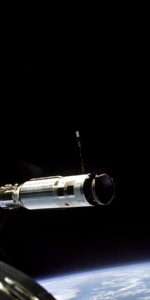
Fifty years ago, this week, it seemed that Project Gemini’s recent spell of tragedy and misfortune was nearing its end. After a spectacular run of five successful missions in 1965—which included America’s first spacewalk and saw the United States move ahead of the Soviet Union with the longest human space mission yet attempted, as well as accomplishing rendezvous between two orbital vehicles for the first time—Gemini seemed to be smoothly clearing the milestones, ahead of Project Apollo. Then, in February 1966, the Gemini IX crew was killed during training and, a few weeks later, the Gemini VIII astronauts came close to losing their lives after accomplishing the first docking in space. With the Gemini IX backup crew of Tom Stafford and Gene Cernan therefore pushed into the shoes of the prime crew, hopes were high that they would launch on 17 May 1966, for an ambitious three-day mission of rendezvous, docking, scientific experiments, and spacewalking.
As outlined in yesterday’s AmericaSpace article, about 99 minutes before their own launch, an Atlas booster at Cape Kennedy’s Pad 14 was scheduled to loft a pencil-like Gemini-Agena Target Vehicle (GATV) into orbit. The Agena—measuring 20.7 feet (6.3 meters) in length—would be used by Stafford and Cernan as a rendezvous and docking target, as well as enabling them to “re-boost” their orbital altitude. Early on 17 May, Stafford and Cernan breakfasted, had biosensors fitted to their bodies, donned their pressure suits, and were ensconced in their seats aboard Gemini IX to await news of the GATV’s successful injection into orbit.
“Success”, though, was in woefully short supply that day.

Inside their spacecraft, atop a Titan II booster on nearby Pad 19, the astronauts waited for news of the Atlas-Agena’s progress. At four seconds before liftoff, the engines ignited—generating 390,000 pounds (177,000 kg) of propulsive yield, via a central “sustainer” and two boosters—and the rocket departed Pad 14 on-time at 10:12 a.m. EDT. Within a minute of leaving the Cape, it vanished from view into the clouds, with all indications that the flight was proceeding normally. At 134 seconds, it was anticipated that the Atlas’ twin boosters would exhaust their supply of liquid oxygen and kerosene and be jettisoned. This would leave the central sustainer alone to continue the boost for the next three minutes, ahead of the separation of the Agena and its own “burn” to enter a preliminary orbit.
It was a little more than two minutes after launch that Deputy Public Affairs Officer Albert “Al” Chop reported “a temporary loss of data,” then quickly added: “It’s coming back in now.” This was to be the start of several anxious minutes waiting to learn if the trials of Gemini IX were yet over. As those minutes dragged on, the mood on the ground deteriorated. Telemetry indicated that the sustainer had shut down at T+300 seconds and that the separation of the Agena had taken place. It was then intended that the Agena would fire its engine for the first time, then conduct a second burn over Ascension Island, to establish itself into a low, circular orbit. It did not happen. Four hundred and thirty-six seconds after leaving the Cape, at an altitude of 18.3 miles (29.5 km), the Agena’s transmissions—together with all other telemetry from either of the two vehicles—abruptly ceased.
In the back row of the Mission Operations Control Room (MOCR) at the Manned Spacecraft Center (MSC) in Houston, Texas, center director Bob Gilruth and the new head of Flight Operations, Chris Kraft, watched the proceedings with intensity. In his memoir, Flight, Kraft described himself as “an uneasy watcher instead of an active participant.” He would subsequently have good cause for his unease. “We watched the plot-boards as it climbed along its programmed trajectory,” Kraft wrote. “And we watched it turn sharply from its course, head off in the wrong direction and destroy itself.”
Investigators would later determine that the calamity occurred about 120.6 seconds into the flight. “One of the two main engines,” recalled Gene Cernan in his autobiography, The Last Man on the Moon, “went weird.” The Atlas’ No. 2 booster engine wobbled, then inexplicably gimbaled into a full-pitchdown position, placing the entire rocket into an uncontrollable tumble. All efforts by the stabilization system to correct the glitch proved useless. As programmed, the Atlas booster engines shut down at T+134 seconds and the 7,190-pound (3,260 kg) Agena separated and entered independent flight. However, as Cernan explained, “it was too late, too low, too fast and all wrong.” So wrong, in fact, that the 216-degree pitchdown—far higher than the 67-degree “nominal” position—had effectively pointed it northwards, back toward Cape Kennedy, with a climbing-angle only 13 degrees above horizontal. …

As if matters could not get worse, they did. The pitchdown had rotated the vehicle into a position where it was impossible for guidance control to achieve a solid lock-on, with radar data from the Grand Bahama Island station indicating a northward, descending trajectory. Stafford and Cernan’s Agena plunged into the waters of the Atlantic Ocean, about 107 miles (172 km) northeast of the launch site and 90 miles (145 km) off the Florida coast, at 10:19 a.m. EDT. Thirteen million dollars’ worth of hardware was gone; all the result, it later became apparent, of a short in a servo control circuit.
Aware that the Gemini IX astronauts were patiently waiting for their 11:41 a.m. EDT launch, Gilruth knew Tom Stafford’s penchant for colorful language. He turned to Kraft.
“What do you suppose Stafford’s saying about now?”
“I don’t know,” said Kraft, “but you can bet that it isn’t Oh, shucks!”
They were right. Aboard Gemini IX, Stafford’s first reaction was “aw, shit,” as the second Atlas-Agena of his astronaut career vanished. He and Cernan quickly inserted the safety pins back into their ejection seats’ safe-and-arm devices and Pad Leader Guenter Wendt’s team began the laborious process of extracting them from the spacecraft. Despite the disappointment, good fortune glimmered on the horizon. Gemini IX would still fly its mission, thanks to a decision made late the previous year.
In the fall of 1965, NASA had ordered General Dynamics to furnish a backup Atlas. In response, McDonnell prepared an alternate rendezvous vehicle, known as the Augmented Target Docking Adapter (ATDA). It had to be ready, the agency stipulated, within two weeks of an accident. Early in February 1966, the ATDA arrived at Cape Kennedy and was placed into storage for the very eventuality that NASA now faced with Gemini IX. Within hours of the failure, NASA formally approved the use of the ATDA and its Atlas for launch on the first day of June.
Nicknamed “The Blob” by the astronauts, the ATDA closely resembled the Agena from the front and carried a docking collar, covered by a fiberglass cone; the latter would be jettisoned shortly after it reached orbit. Within a week of the Atlas-Agena failure, investigators concluded that a pinched wire in the rocket’s autopilot had caused the short circuit, which prompted further work on its electrical connectors. For Stafford and Cernan, nothing would prevent them from their rendezvous mission. Even if the ATDA failed to achieve orbit, they planned to utilize the second stage of their Titan II booster as a rendezvous target. Fortunately, the ATDA was launched successfully on 1 June, putting it in position for one of the most ambitious missions in NASA history.
This is part of a series of history articles, which will appear each weekend, barring any major news stories. Next week’s article will focus on the 20th anniversary of STS-77, a mission of science and technology in May 1996, with U.S., Canadian, and Australian crew members.
Want to keep up-to-date with all things space? Be sure to “Like” AmericaSpace on Facebook and follow us on Twitter: @AmericaSpace






The Gemini articles are rich in detail and give readers who were either not born or too young to remember a significant chapter in American manned spaceflight. Great job, Ben! Thank you.